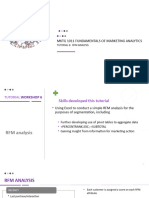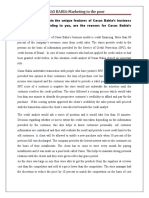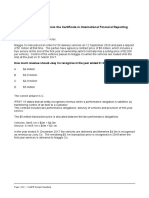How To Do Breakeven Analysis
How To Do Breakeven Analysis
Uploaded by
ranjankathuriaCopyright:
Available Formats
How To Do Breakeven Analysis
How To Do Breakeven Analysis
Uploaded by
ranjankathuriaOriginal Title
Copyright
Available Formats
Share this document
Did you find this document useful?
Is this content inappropriate?
Copyright:
Available Formats
How To Do Breakeven Analysis
How To Do Breakeven Analysis
Uploaded by
ranjankathuriaCopyright:
Available Formats
11/4/13
How to Do Breakeven Analysis
Entrepreneurs
How to Do a Breakeven Analysis
Breakeven analysis helps determine when your business revenues equal your costs
By Daniel Richards
If you can accurately forecast your costs and sales, conducting a breakeven analysis is a matter of simple math. A company has broken even when its total sales or revenues equal its total expenses. At the breakeven point, no profit has been made, nor have any losses been incurred. This calculation is critical for any business owner, because the breakeven point is the lower limit of profit when determining margins. Defining Costs There are several types of costs to consider when conducting a breakeven analysis, so here's a refresher on the most relevant. Fixed costs: These are costs that are the same regardless of how many items you sell. All start-up costs, such as rent, insurance and computers, are considered fixed costs since you have to make these outlays before you sell your first item. Variable costs: These are recurring costs that you absorb with each unit you sell. For example, if you were operating a greeting card store where you had to buy greeting cards from a stationary company for $1 each, then that dollar represents a variable cost. As your business and sales grow, you can begin appropriating labor and other items as variable costs if it makes sense for your industry. Setting a Price This is critical to your breakeven analysis; you can't calculate likely revenues if you don't know what the unit price will be. Unit price refers to the amount you plan to charge customers to buy a single unit of your product. Psychology of Pricing: Pricing can involve a complicated decision-making process on the part of the consumer, and there is plenty of research on the marketing and psychology of how consumers perceive price. Take the time to review articles on pricing strategy1 and the psychology of pricing 2 before choosing how to price your product or service. Pricing Methods: There are several different schools of thought on how to treat price when conducting a breakeven analysis. It is a mix of quantitative and qualitative factors. If you've created a brand new, unique product, you should be able to charge a premium price, but if you're entering a competitive industry, you'll have to keep the price in line with the going rate or perhaps even offer a discount to get customers to switch to your company. One common strategy is "cost-based pricing", which calls for figuring out how much it will cost to produce one unit of an item and setting the price
entrepreneurs.about.com/od/businessplan/a/breakeven.htm?p=1 1/3
11/4/13
How to Do Breakeven Analysis
to that amount plus a predetermined profit margin. This approach is frowned upon since it allows competitors who can make the product for less than you to easily undercut you on price. Another method, referred to by David G. Bakken of Harris Interactive as "price-based costing" encourages business owners to "start with the price that consumers are willing to pay (when they have competitive alternatives) and whittle down costs to meet that price." That way if you encounter new competition, you can lower your price and still turn a profit. There are always different pricing methods 3 that can be used. The formula: Don't worry, it's fairly simple. To conduct your breakeven analysis, take your fixed costs, divided by your price, minus your variable costs. As an equation, this is defined as: B r e a k e v e nP o i n t=F i x e dC o s t s / ( U n i tS e l l i n gP r i c e-V a r i a b l eC o s t s ) This calculation will let you know how many units of a product you'll need to sell to break even. Once you've reached that point, you've recovered all costs associated with producing your product (both variable and fixed). Above the breakeven point, every additional unit sold increases profit by the amount of the unit contribution margin, which is defined as the amount each unit contributes to covering fixed costs and increasing profits. As an equation, this is defined as: U n i tC o n t r i b u t i o nM a r g i n=S a l e sP r i c e-V a r i a b l eC o s t s Recording this information in a spreadsheet will allow you to easily make adjustments as costs change over time, as well as play with different price options and easily calculate the resulting breakeven point. You could use a program such as Excel's Goal Seek, if you wanted to give yourself a goal of a certain profit, say $1 million, and then work backwards to see how many units you would need to sell to hit that number. (This online tutorial4 will show you how to use Goal Seek.) Calculators There are several online calculators to assist you with your breakeven analysis: Case Western Reserve University offers a breakeven analysis calculator5 that includes a review of relevant microeconomic terms. This financial calculator6 allows you to chart your costs and profits appear in a graph. Inc.com offers a breakeven analysis calculator7 that requires a user to enter in total annual overhead and annual year-to-date sales and cost of sales, and lets the user delineate the period for the YTD calculations in terms of weeks. Limitations It is important to understand what the results of your breakeven analysis are telling you. If, for example, the calculation reports that you would break even when you sold your 500th unit, decide whether this seems feasible. If you don't think you can sell 500 units within a reasonable period of time
entrepreneurs.about.com/od/businessplan/a/breakeven.htm?p=1 2/3
11/4/13
How to Do Breakeven Analysis
(dictated by your financial situation, patience and personal expectations), then this may not be the right business for you to go into. If you think 500 units is possible but would take a while, try lowering your price and calculating and analyzing the new breakeven point. Alternatively, take a look at your costs - both fixed and variable - and identify areas where you might be able to make cuts. Lastly, understand that breakeven analysis is not a predictor of demand, so if you go into market with the wrong product or the wrong price, it may be tough to ever hit the breakeven point.
This About.com page has been optimized for print. To view this page in its original form, please visit: http://entrepreneurs.about.com/od/businessplan/a/breakeven.htm 2013 About.com, Inc. All rights reserved.
Links in this article: 1. http://e ntre pre ne urs.about.com /od/sale sm ark e ting/a/pricingstrate gy.htm 2. http://www.m ark e tingpsychology.com /price 1.htm 3. http://e ntre pre ne urs.about.com /od/sale sm ark e ting/a/pricingstrate gy_2.htm 4. http://www.hom e andle arn.co.uk /ME/m e s8p4.htm l 5. http://conne ction.cwru.e du/m bac424/bre ak e ve n/Bre ak Eve n.htm l 6. http://dink ytown.com /java/Bre ak Eve n.htm l 7. http://www.inc.com /article s/2003/10/sim ple form ula.htm l
entrepreneurs.about.com/od/businessplan/a/breakeven.htm?p=1
3/3
You might also like
- Model Solution - Assessment 1Document20 pagesModel Solution - Assessment 1R K Singh67% (3)
- Creating Connections A Systems Thinking Approach To Content CreationDocument44 pagesCreating Connections A Systems Thinking Approach To Content Creationstha86584No ratings yet
- Korean Coffee Discussion QuestionDocument15 pagesKorean Coffee Discussion QuestionShreyNo ratings yet
- Sales Forecasting ProjectDocument8 pagesSales Forecasting ProjectVipul KothariNo ratings yet
- Break Even Analysis: Pricing Strategy Psychology of PricingDocument3 pagesBreak Even Analysis: Pricing Strategy Psychology of Pricingnamita patharkarNo ratings yet
- Break Even Analysis FMDocument6 pagesBreak Even Analysis FMRahul RajwaniNo ratings yet
- Corporate ValuationDocument9 pagesCorporate ValuationSwapnil KolheNo ratings yet
- Break-Even Point Formula and AnalysisDocument4 pagesBreak-Even Point Formula and AnalysissvillacNo ratings yet
- Break Even Point ThesisDocument5 pagesBreak Even Point ThesisGhostWriterCollegePapersUK100% (2)
- How To Calculate Break Even PointDocument4 pagesHow To Calculate Break Even Pointmohamed abd el khalekNo ratings yet
- Break Even Analysis ThesisDocument7 pagesBreak Even Analysis Thesisangeljordancincinnati100% (2)
- Lesson 4 Breakeven AnalysisDocument3 pagesLesson 4 Breakeven AnalysisJamaica TaghoyNo ratings yet
- Cara Menentukan Pricing StrategiesDocument12 pagesCara Menentukan Pricing StrategiesRief RobyNo ratings yet
- How To Start A Business GuideDocument3 pagesHow To Start A Business GuideVictor JosephNo ratings yet
- Illustration 1: Break-Even AnalysisDocument3 pagesIllustration 1: Break-Even AnalysisAsif Rajian Khan AponNo ratings yet
- Bsacore2 M7 SatDocument4 pagesBsacore2 M7 Satilalimngputingilaw3No ratings yet
- Marketing ManagementDocument3 pagesMarketing Managementagnes lorenzaNo ratings yet
- PricingDocument19 pagesPricingAmal JoseNo ratings yet
- Break Even AnalysisDocument3 pagesBreak Even AnalysisNikhil AgrawalNo ratings yet
- Business Plan Financial ProjectionsDocument5 pagesBusiness Plan Financial ProjectionssweetpiyajNo ratings yet
- Literature Review On Break Even AnalysisDocument6 pagesLiterature Review On Break Even Analysisafdtfhtut100% (1)
- Forecasting Revenues and Cost To Be IncurredDocument7 pagesForecasting Revenues and Cost To Be IncurredCharley Vill Credo100% (1)
- C CC C CCDocument3 pagesC CC C CCTushar BhaipNo ratings yet
- Lecture11 TE 13may BreakevenAnalysisDocument3 pagesLecture11 TE 13may BreakevenAnalysisFassikaw EjjiguNo ratings yet
- 1.forecasting The Revenues of The Business 2.forecasting The Cost To Be IncurredDocument29 pages1.forecasting The Revenues of The Business 2.forecasting The Cost To Be IncurredDimple MontemayorNo ratings yet
- Plan Your Advertising BudgetDocument5 pagesPlan Your Advertising BudgetSyria DamascusNo ratings yet
- Will Your Business Start To Make A Profit.: What Is Break-Even?Document12 pagesWill Your Business Start To Make A Profit.: What Is Break-Even?zahida kayaniNo ratings yet
- Finance ConceptsDocument15 pagesFinance Conceptsgodwillinno1997No ratings yet
- Microsoft Excel Breakeven Point Template Business School Even Activities For Children Earning Online LearningDocument12 pagesMicrosoft Excel Breakeven Point Template Business School Even Activities For Children Earning Online LearningAtri BanerjeeNo ratings yet
- The Art of Pricing (Review and Analysis of Mohammed's Book)From EverandThe Art of Pricing (Review and Analysis of Mohammed's Book)No ratings yet
- Economics For Engineers Amit Kumar ChoudharyDocument6 pagesEconomics For Engineers Amit Kumar Choudharyankit.real12No ratings yet
- Break Even AnalysisDocument14 pagesBreak Even AnalysisBabacar Tall100% (1)
- Break Even DescriptionDocument16 pagesBreak Even DescriptionTabrej KhanNo ratings yet
- PR Ede 17Document2 pagesPR Ede 17Asad MoinuddinNo ratings yet
- Pricing ModelsDocument7 pagesPricing ModelsmullahpyNo ratings yet
- What Is A Sales Forecast?Document7 pagesWhat Is A Sales Forecast?Mr.SDNo ratings yet
- Pricing Policy: Policy Company Determines Wholesale Products ServicesDocument4 pagesPricing Policy: Policy Company Determines Wholesale Products ServicesGhost_1990No ratings yet
- LAS 4 Entrep 4th QuarterDocument6 pagesLAS 4 Entrep 4th QuarterKawaguchi OerkeNo ratings yet
- Forcasting of RevenueDocument15 pagesForcasting of RevenueJIYAN BERACISNo ratings yet
- Increase Your ProfitabilityDocument5 pagesIncrease Your ProfitabilityMilon SultanNo ratings yet
- Break EvenDocument1 pageBreak Evencarrol jane labisNo ratings yet
- Break EvenDocument1 pageBreak Evencarrol jane labisNo ratings yet
- State Four Underlying Assumptions For Cost-Volume-Profit AnalysisDocument7 pagesState Four Underlying Assumptions For Cost-Volume-Profit Analysismehazabin anamikaNo ratings yet
- Module 2 Lecture Transcript (II)Document61 pagesModule 2 Lecture Transcript (II)Kingshuk SarkarNo ratings yet
- Break Even AnalysisalanDocument15 pagesBreak Even AnalysisalanFelipe Irazábal0% (1)
- Lean Pricing StartupsDocument31 pagesLean Pricing StartupsJuan PC100% (2)
- Break Even Analysis Term PaperDocument5 pagesBreak Even Analysis Term Paperc5khavcy100% (1)
- CHAPTER III. Pricing StrategiesDocument10 pagesCHAPTER III. Pricing StrategiesMa. Lotie Torres VillamarinNo ratings yet
- Sikkim Manipal University - Mba - MF0011 Â " Mergers and AcquisitionsDocument15 pagesSikkim Manipal University - Mba - MF0011 Â " Mergers and AcquisitionsdineshlengoNo ratings yet
- Student Report Template Business Unit 3Document8 pagesStudent Report Template Business Unit 39dknhnsd7tNo ratings yet
- Module 6Document5 pagesModule 6Joe DomarsNo ratings yet
- GalangAsync#1 September 26Document4 pagesGalangAsync#1 September 26Genevieve AllysonNo ratings yet
- How To Price Your ProductDocument11 pagesHow To Price Your ProductNayan MhetreNo ratings yet
- Chapter 15 - PricingDocument39 pagesChapter 15 - PricingstoreostakeNo ratings yet
- 2.1.VCH - The Top 5 Things To Consider Before Pricing Your ProductsDocument3 pages2.1.VCH - The Top 5 Things To Consider Before Pricing Your ProductsrenudogNo ratings yet
- Topic For Marketing ConceptDocument3 pagesTopic For Marketing ConceptBibs GravosoNo ratings yet
- Costing and PricingDocument5 pagesCosting and PricingElvis Pahigo MarataNo ratings yet
- Cost Function AnalysisDocument6 pagesCost Function AnalysisSamson IsabokeNo ratings yet
- Unit 3Document11 pagesUnit 3BHUWNESH AGARWALNo ratings yet
- (A) - How Feasibility Analysis Helps Entrepreneurs in Assessing The Viability of A New Venture. AnswerDocument5 pages(A) - How Feasibility Analysis Helps Entrepreneurs in Assessing The Viability of A New Venture. AnswerMuhammad Muzamil HussainNo ratings yet
- Smart Pricing (Review and Analysis of Raju and Zhang's Book)From EverandSmart Pricing (Review and Analysis of Raju and Zhang's Book)Rating: 4 out of 5 stars4/5 (1)
- Tutorial 6 SlidesDocument7 pagesTutorial 6 Slideslehoangson220801No ratings yet
- Impact of Packaging On Consumer Buying PDFDocument6 pagesImpact of Packaging On Consumer Buying PDFJohn-Ross ReyesNo ratings yet
- Ch.5 Book Exercise + AnswerDocument36 pagesCh.5 Book Exercise + Answertomsuen63No ratings yet
- Elc Task Week 4Document2 pagesElc Task Week 42022603024No ratings yet
- A Study On Consumer's Behaviour Towards Dabur and Its ProductsDocument52 pagesA Study On Consumer's Behaviour Towards Dabur and Its Productsgangam sourabhNo ratings yet
- Welcome To Parkson Supplier Portal (Ver 3.3.0.1)Document1 pageWelcome To Parkson Supplier Portal (Ver 3.3.0.1)Mashiey MokhtarNo ratings yet
- Marketing PlanDocument2 pagesMarketing PlanErynRamsudhNo ratings yet
- Millat TractorDocument102 pagesMillat TractorAnonymous vGhPeTramNo ratings yet
- The Industry - Printing (Reference)Document9 pagesThe Industry - Printing (Reference)Nguyệt HồngNo ratings yet
- Assignment: Consumer Behavior (A Need Becomes A Motive When It Is Aroused To ADocument2 pagesAssignment: Consumer Behavior (A Need Becomes A Motive When It Is Aroused To ANaseer Ahmad AziziNo ratings yet
- MGT 3150 All Learning JournalsDocument6 pagesMGT 3150 All Learning Journalsapi-340376954No ratings yet
- Top PopsDocument8 pagesTop PopsFaizan Khan25% (4)
- Effects of Online Advertising On Consumer Buying BehaviourDocument24 pagesEffects of Online Advertising On Consumer Buying BehaviourMICHAEL ADEYEMO100% (1)
- Pricing StrategiesDocument2 pagesPricing StrategiesPuneet GroverNo ratings yet
- Applying The Rossiter-Percy Grid To Online Advertising PlanningDocument10 pagesApplying The Rossiter-Percy Grid To Online Advertising PlanningFerry Scout SpenzaNo ratings yet
- Prcatical e TourismDocument6 pagesPrcatical e TourismSumegha JainNo ratings yet
- Ms4 Text Industry AudienceDocument14 pagesMs4 Text Industry AudienceDee WatsonNo ratings yet
- General Production Assistant DescriptionDocument1 pageGeneral Production Assistant DescriptiondboeversNo ratings yet
- Bykea AssignmentDocument7 pagesBykea AssignmentClassic Vines100% (1)
- CASAS BAHIA-Marketing To The PoorDocument8 pagesCASAS BAHIA-Marketing To The PoorAshley VargheseNo ratings yet
- Deacons - Mr. Price & Bossini Customer Drive PresentationDocument29 pagesDeacons - Mr. Price & Bossini Customer Drive PresentationIbrahim AbahoNo ratings yet
- Growth Marketing PORTFOLIODocument15 pagesGrowth Marketing PORTFOLIOAkinola OluwashinaNo ratings yet
- ASM Boutique Group MeorDocument19 pagesASM Boutique Group MeorAmirAircoolNo ratings yet
- Maharashtra National Law University, MumbaiDocument13 pagesMaharashtra National Law University, MumbaiAnkur mishraNo ratings yet
- Two Example Questions From The Certificate in International Financial Reporting (Certifr) AssessmentDocument2 pagesTwo Example Questions From The Certificate in International Financial Reporting (Certifr) AssessmentAbirami AbiNo ratings yet
- Presentasi Kelompok 1 Interpretasi Data Paper Marketing Dengan Analisa KuantitatifDocument13 pagesPresentasi Kelompok 1 Interpretasi Data Paper Marketing Dengan Analisa KuantitatifAdit FinosNo ratings yet
- Activity 1.5. Page 17 Essence and Essentials of Purposive Communication in The 21st CenturyDocument1 pageActivity 1.5. Page 17 Essence and Essentials of Purposive Communication in The 21st CenturyAcademic HelpNo ratings yet

























































































